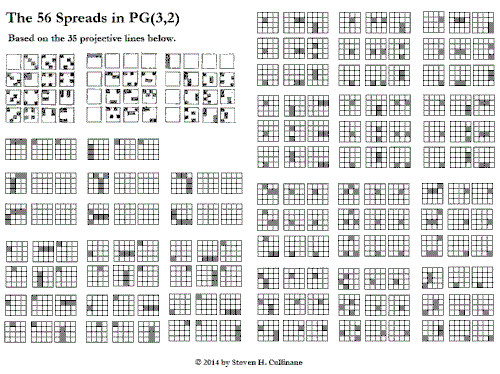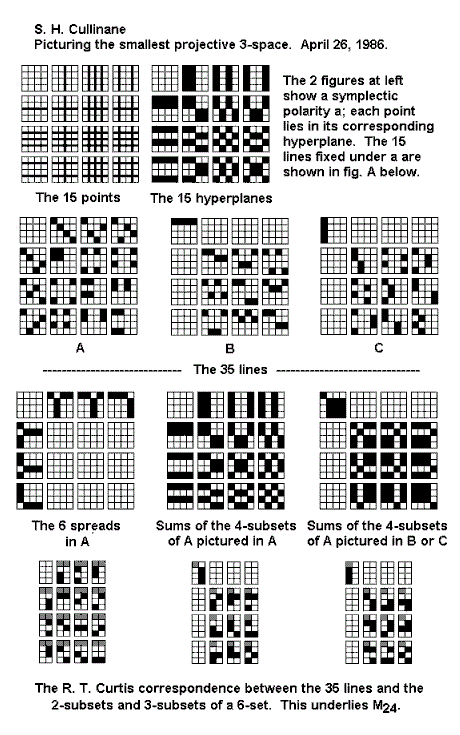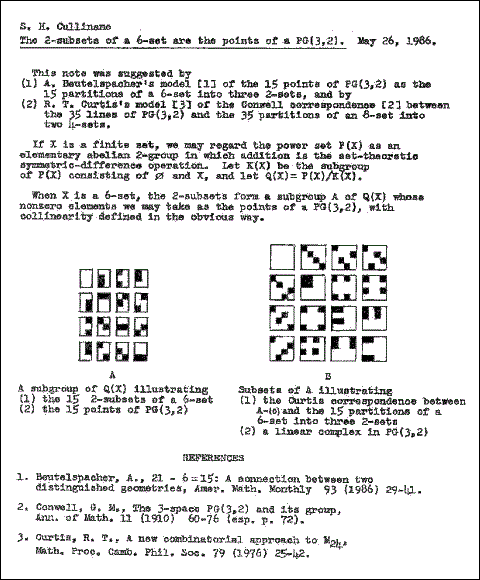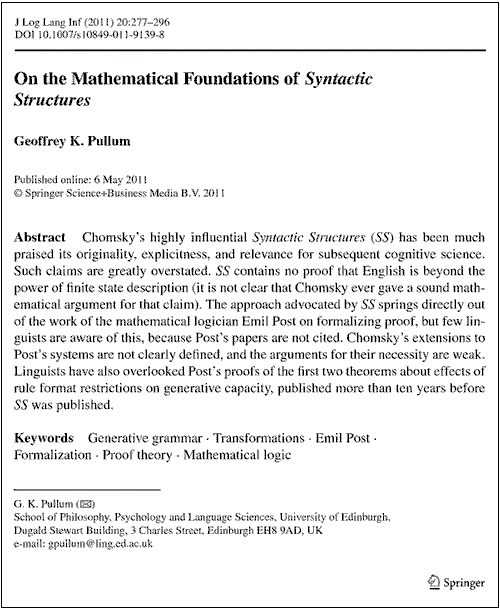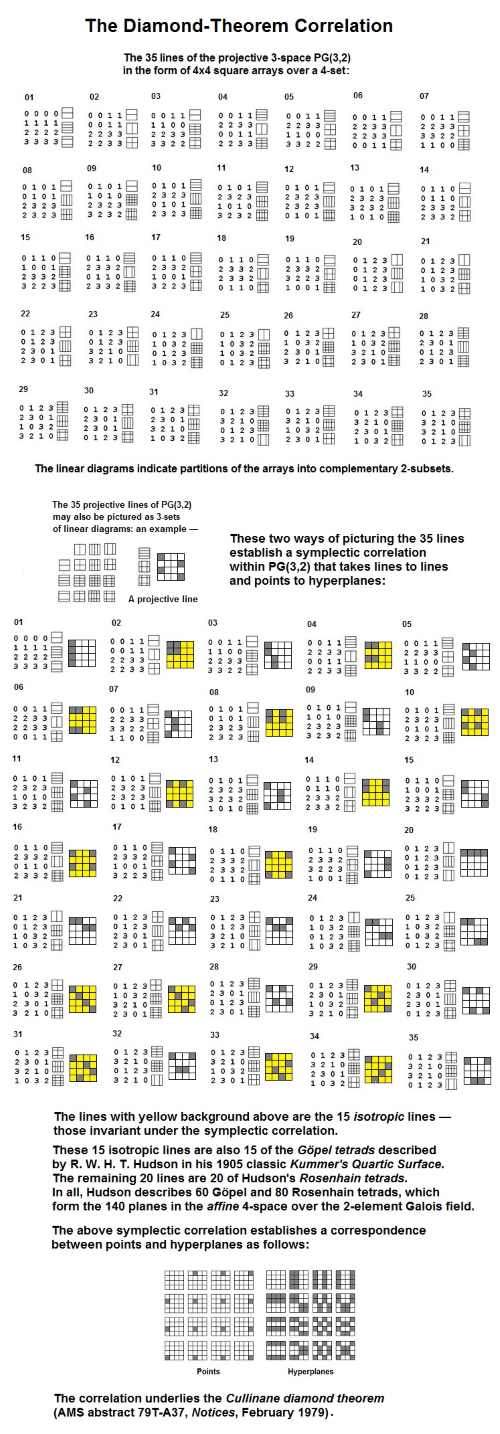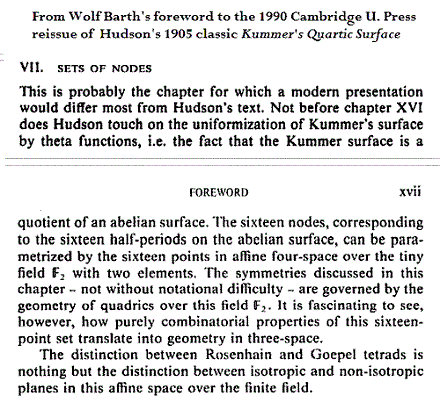The previous post suggests a Log24 search for
Rosenhain, of "Rosenhain and Göpel" fame.
Tuesday, December 19, 2023
Rosenhain Revisited
Tuesday, March 15, 2022
The Rosenhain Symmetry
See other posts now so tagged.
Hudson's Rosenhain tetrads, as 20 of the 35 projective lines in PG(3,2),
illustrate Desargues's theorem as a symmetry within 10 pairs of squares
under rotation about their main diagonals:
See also "The Square Model of Fano's 1892 Finite 3-Space."
The remaining 15 lines of PG(3,2), Hudson's Göpel tetrads, have their
own symmetries . . . as the Cremona-Richmond configuration.
Thursday, November 22, 2018
Rosenhain and Göpel Meet Kummer in Projective 3-Space
For further details, see finitegeometry.org/sc/35/hudson.html.
Sunday, December 11, 2016
Complexity to Simplicity via Hudson and Rosenhain*
*The Hudson of the title is the author of Kummer's Quartic Surface (1905).
The Rosenhain of the title is the author for whom Hudson's 4×4 diagrams
of "Rosenhain tetrads" are named. For the "complexity to simplicity" of
the title, see Roger Fry in the previous post.
Tuesday, May 24, 2016
Rosenhain and Göpel Revisited
The authors Taormina and Wendland in the previous post
discussed some mathematics they apparently did not know was
related to a classic 1905 book by R. W. H. T. Hudson, Kummer's
Quartic Surface .
"This famous book is a prototype for the possibility
of explaining and exploring a many-faceted topic of
research, without focussing on general definitions,
formal techniques, or even fancy machinery. In this
regard, the book still stands as a highly recommendable,
unparalleled introduction to Kummer surfaces, as a
permanent source of inspiration and, last but not least,
as an everlasting symbol of mathematical culture."
— Werner Kleinert, Mathematical Reviews ,
as quoted at Amazon.com
Some 4×4 diagrams from that book are highly relevant to the
discussion by Taormina and Wendland of the 4×4 squares within
the 1974 Miracle Octad Generator of R. T. Curtis that were later,
in 1987, described by Curtis as pictures of the vector 4-space over
the two-element Galois field GF(2).
Hudson did not think of his 4×4 diagrams as illustrating a vector space,
but he did use them to picture certain subsets of the 16 cells in each
diagram that he called Rosenhain and Göpel tetrads .
Some related work of my own (click images for related posts)—
Rosenhain tetrads as 20 of the 35 projective lines in PG(3,2)
Göpel tetrads as 15 of the 35 projective lines in PG(3,2)
Related terminology describing the Göpel tetrads above

Sunday, June 22, 2014
Göpel and Rosenhain
Some bizarre remarks on “purity” in the previous post
suggest a review of some pure mathematics.
Wednesday, March 5, 2014
Rosenhain and Göpel Again
See also Rosenhain and Göpel in the Wikipedia
article Kummer surface, and in this journal.
Related material: user @hyperelliptic on Twitter.
Saturday, February 15, 2014
Rosenhain and Göpel
See The Oslo Version in this journal and the New Year’s Day 2014 post.
The pictures of the 56 spreads in that post (shown below) are based on
the 20 Rosenhain and 15 Göpel tetrads that make up the 35 lines of
PG(3,2), the finite projective 3-space over the 2-element Galois field.
Click for a larger image.
Thursday, April 25, 2013
Rosenhain and Göpel Revisited
Some historical background for today's note on the geometry
underlying the Curtis Miracle Octad Generator (MOG):
The above incidence diagram recalls those in today's previous post
on the MOG, which is used to construct the large Mathieu group M24.
For some related material that is more up-to-date, search the Web
for Mathieu + Kummer .
Monday, April 1, 2013
Desargues via Rosenhain
Background: Rosenhain and Göpel Tetrads in PG(3,2)
|
Introduction: The Large Desargues Configuration Added by Steven H. Cullinane on Friday, April 19, 2013 Desargues' theorem according to a standard textbook:
"If two triangles are perspective from a point The converse, from the same book:
"If two triangles are perspective from a line
Desargues' theorem according to Wikipedia
"Two triangles are in perspective axially [i.e., from a line]
A figure often used to illustrate the theorem,
A discussion of the "if and only if" version of the theorem
This large Desargues configuration involves a third triangle,
Point-line incidence in this larger configuration is,
The third triangle, within the larger configuration,
|
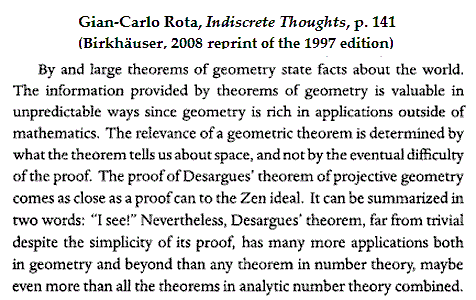
A connection discovered today (April 1, 2013)—
(Click to enlarge the image below.)
Update of April 18, 2013
Note that Baker's Desargues-theorem figure has three triangles,
ABC, A'B'C', A"B"C", instead of the two triangles that occur in
the statement of the theorem. The third triangle appears in the
course of proving, not just stating, the theorem (or, more precisely,
its converse). See, for instance, a note on a standard textbook for
further details.
(End of April 18, 2013 update.)
Update of April 14, 2013
See Baker's Proof (Edited for the Web) for a detailed explanation
of the above picture of Baker's Desargues-theorem frontispiece.
(End of April 14, 2013 update.)
Update of April 12, 2013
A different figure, from a site at National Tsing Hua University,
shows the three triangles of Baker's figure more clearly:
(End of update of April 12, 2013)
Update of April 13, 2013
Another in a series of figures illustrating
Desargues's theorem in light of Galois geometry:

See also the original Veblen-Young figure in context.
(End of update of April 13, 2013)
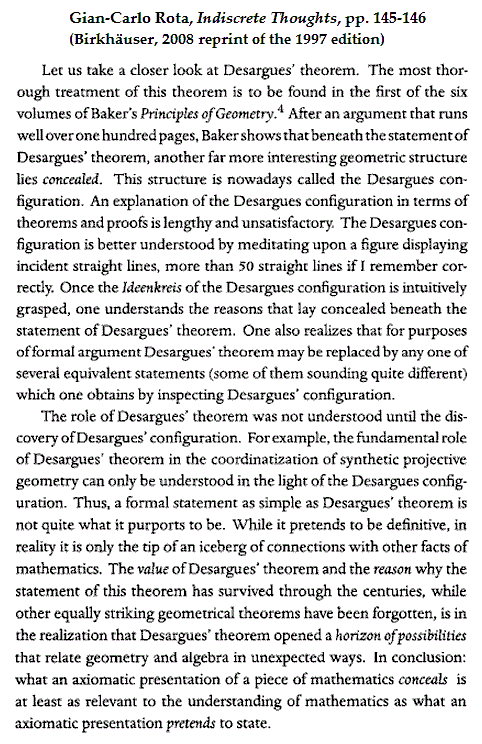
Rota's remarks, while perhaps not completely accurate, provide some context
for the above Desargues-Rosenhain connection. For some other context,
see the interplay in this journal between classical and finite geometry, i.e.
between Euclid and Galois.
For the recent context of the above finite-geometry version of Baker's Vol. I
frontispiece, see Sunday evening's finite-geometry version of Baker's Vol. IV
frontispiece, featuring the Göpel, rather than the Rosenhain, tetrads.
For a 1986 illustration of Göpel and Rosenhain tetrads (though not under
those names), see Picturing the Smallest Projective 3-Space.
In summary… the following classical-geometry figures
are closely related to the Galois geometry PG(3,2):
|
Volume I of Baker's Principles has a cover closely related to the Rosenhain tetrads in PG(3,2) |
Volume IV of Baker's Principles has a cover closely related to the Göpel tetrads in PG(3,2) |
|
Foundations (click to enlarge)
|
Higher Geometry (click to enlarge)
|
Sunday, August 11, 2024
Double Duals
"That in which space itself is contained"
— Wallace Stevens
In the ninefold square,
projective-perspectivity duality
corresponds to
projective-correlation duality.
Illustrations —
Monday, June 17, 2024
Culture Note: Thinking Inside the Box
A more specific account of
Outside/Inside box-thinking . . .
|
A connection discovered on April 1, 2013 — |
Sunday, December 24, 2023
Infolded Perspectives
Infolded:
“In the garden of Adding,
Live Even and Odd….”
— The Midrash Jazz Quartet in
City of God , by E. L. Doctorow
Perspectives:
Wednesday, December 20, 2023
Humanities Copilot
Tyler Austin Harper in The Atlantic yesterday —
"If we have any hope of resuscitating fields like English and history,
we must rescue the humanities from the utilitarian appraisals that
both their champions and their critics subject them to. We need to
recognize that the conservatives are right, albeit not in the way
they think: The humanities are useless in many senses of the term.
But that doesn’t mean they’re without value."
"English and history" … and pure mathematics.
Perhaps AI can help . . .
Microsoft's Copilot AI on Monday, Dec. 18, retrieved work by
the nineteenth-century mathematicians Rosenhain and Göpel —
Tuesday, December 19, 2023
Copilot Report
|
From Microsoft Copilot (with "Precise" setting)
on Dec. 18, 2023 —
How is the 1910 work of G. M. Conwell on PG(3,2) related to the Miracle Octad Generator of R. T. Curtis?
Searching for:
Searching for: Generating answers for you… The work of George M. Conwell on the finite projective 3-space PG(3,2) and the Miracle Octad Generator (MOG) of R. T. Curtis are both significant contributions to the field of combinatorial mathematics12. Conwell’s work on PG(3,2) provided a detailed study of the structure of this finite projective space1. On the other hand, the MOG is a tool for exploring the binary Golay code and its automorphism group M242. The connection between these two works lies in the underlying combinatorial structures they explore. The Rosenhain and Göpel tetrads, which are key structures in the finite geometry PG(3,2), play a significant role in the Curtis Miracle Octad Generator3. These structures provide a link between the finite geometric structures studied by Conwell and the combinatorial structures generated by the MOG3. For a more detailed understanding of this connection, I recommend checking out the resources mentioned in the references123. If you have any specific questions about the concepts in these works, feel free to ask! I’ll do my best to help. Learn more
5
_________________________________________________________
__________________________________________________________
Here is a summary of the document:
Reference:
|
Correction:
"Subsets of four points in a projective 3-space" above is a Copilot error, and not
from the document being summarized. It should be "subsets of four points in an
affine 4-space."
Tuesday, March 15, 2022
Midnight Wrinkle

See as well the life of a real astrophysicist.
Update of 12:26 PM ET March 15:
Vide other posts now tagged The Rosenhain Symmetry.
Wednesday, February 23, 2022
Friday, February 21, 2020
Thursday, August 29, 2019
As Well
For some backstory, see
http://m759.net/wordpress/?s=”I+Ching”+48+well .
See as well “elegantly packaged” in this journal.
“Well” in written Chinese is the hashtag symbol,
i.e., the framework of a 3×3 array.
My own favorite 3×3 array is the ABC subsquare
at lower right in the figure below —
Tuesday, October 23, 2018
Sunday, September 9, 2018
Plan 9 Continues.
"The role of Desargues's theorem was not understood until
the Desargues configuration was discovered. For example,
the fundamental role of Desargues's theorem in the coordinatization
of synthetic projective geometry can only be understood in the light
of the Desargues configuration.
Thus, even as simple a formal statement as Desargues's theorem
is not quite what it purports to be. The statement of Desargues's theorem
pretends to be definitive, but in reality it is only the tip of an iceberg
of connections with other facts of mathematics."
— From p. 192 of "The Phenomenology of Mathematical Proof,"
by Gian-Carlo Rota, in Synthese , Vol. 111, No. 2, Proof and Progress
in Mathematics (May, 1997), pp. 183-196. Published by: Springer.
Stable URL: https://www.jstor.org/stable/20117627.
Related figures —
Note the 3×3 subsquare containing the triangles ABC, etc.
"That in which space itself is contained" — Wallace Stevens
Friday, February 16, 2018
Two Kinds of Symmetry
The Institute for Advanced Study (IAS) at Princeton in its Fall 2015 Letter
revived "Beautiful Mathematics" as a title:
This ugly phrase was earlier used by Truman State University
professor Martin Erickson as a book title. See below.
In the same IAS Fall 2015 Letter appear the following remarks
by Freeman Dyson —
". . . a special case of a much deeper connection that Ian Macdonald
discovered between two kinds of symmetry which we call modular and affine.
The two kinds of symmetry were originally found in separate parts of science,
modular in pure mathematics and affine in physics. Modular symmetry is
displayed for everyone to see in the drawings of flying angels and devils
by the artist Maurits Escher. Escher understood the mathematics and got the
details right. Affine symmetry is displayed in the peculiar groupings of particles
created by physicists with high-energy accelerators. The mathematician
Robert Langlands was the first to conjecture a connection between these and
other kinds of symmetry. . . ." (Wikipedia link added.)
The adjective "modular" might aptly be applied to . . .

The adjective "affine" might aptly be applied to . . .
The geometry of the 4×4 square combines modular symmetry
(i.e., related to theta functions) with the affine symmetry above.
Hudson's 1905 discussion of modular symmetry (that of Rosenhain
tetrads and Göpel tetrads) in the 4×4 square used a parametrization
of that square by the digit 0 and the fifteen 2-subsets of a 6-set, but
did not discuss the 4×4 square as an affine space.
For the connection of the 15 Kummer modular 2-subsets with the 16-
element affine space over the two-element Galois field GF(2), see my note
of May 26, 1986, "The 2-subsets of a 6-set are the points of a PG(3,2)" —
— and the affine structure in the 1979 AMS abstract
"Symmetry invariance in a diamond ring" —
For some historical background on the symmetry investigations by
Dyson and Macdonald, see Dyson's 1972 article "MIssed Opportunities."
For Macdonald's own use of the words "modular" and "affine," see
Macdonald, I. G., "Affine Lie algebras and modular forms,"
Séminaire N. Bourbaki , Vol. 23 (1980-1981), Talk no. 577, pp. 258-276.
Sunday, December 10, 2017
Geometry
See also Symplectic in this journal.
From Gotay and Isenberg, “The Symplectization of Science,”
Gazette des Mathématiciens 54, 59-79 (1992):
“… what is the origin of the unusual name ‘symplectic’? ….
Its mathematical usage is due to Hermann Weyl who,
in an effort to avoid a certain semantic confusion, renamed
the then obscure ‘line complex group’ the ‘symplectic group.’
… the adjective ‘symplectic’ means ‘plaited together’ or ‘woven.’
This is wonderfully apt….”

The above symplectic figure appears in remarks on
the diamond-theorem correlation in the webpage
Rosenhain and Göpel Tetrads in PG(3,2). See also
related remarks on the notion of linear (or line ) complex
in the finite projective space PG(3,2) —
Friday, April 14, 2017
Hudson and Finite Geometry
The above four-element sets of black subsquares of a 4×4 square array
are 15 of the 60 Göpel tetrads , and 20 of the 80 Rosenhain tetrads , defined
by R. W. H. T. Hudson in his 1905 classic Kummer's Quartic Surface .
Hudson did not view these 35 tetrads as planes through the origin in a finite
affine 4-space (or, equivalently, as lines in the corresponding finite projective
3-space).
In order to view them in this way, one can view the tetrads as derived,
via the 15 two-element subsets of a six-element set, from the 16 elements
of the binary Galois affine space pictured above at top left.
This space is formed by taking symmetric-difference (Galois binary)
sums of the 15 two-element subsets, and identifying any resulting four-
element (or, summing three disjoint two-element subsets, six-element)
subsets with their complements. This process was described in my note
"The 2-subsets of a 6-set are the points of a PG(3,2)" of May 26, 1986.
The space was later described in the following —

Wednesday, February 15, 2017
Warp and Woof
Space —
Space structure —
From Gotay and Isenberg, “The Symplectization of Science,”
Gazette des Mathématiciens 54, 59-79 (1992):
“… what is the origin of the unusual name ‘symplectic’? ….
Its mathematical usage is due to Hermann Weyl who,
in an effort to avoid a certain semantic confusion, renamed
the then obscure ‘line complex group’ the ‘symplectic group.’
… the adjective ‘symplectic’ means ‘plaited together’ or ‘woven.’
This is wonderfully apt….”

The above symplectic figure appears in remarks on
the diamond-theorem correlation in the webpage
Rosenhain and Göpel Tetrads in PG(3,2).
Space shuttle —
Related ethnic remarks —
… As opposed to Michael Larsen —
Funny, you don't look Danish.
Wednesday, November 23, 2016
Yogiism
From the American Mathematical Society (AMS) webpage today —
From the current AMS Notices —
Related material from a post of Aug. 6, 2014 —

(Here "five point sets" should be "five-point sets.")
From Gotay and Isenberg, “The Symplectization of Science,”
Gazette des Mathématiciens 54, 59-79 (1992):
“… what is the origin of the unusual name ‘symplectic’? ….
Its mathematical usage is due to Hermann Weyl who,
in an effort to avoid a certain semantic confusion, renamed
the then obscure ‘line complex group’ the ‘symplectic group.’
… the adjective ‘symplectic’ means ‘plaited together’ or ‘woven.’
This is wonderfully apt….”

The above symplectic structure* now appears in the figure
illustrating the diamond-theorem correlation in the webpage
Rosenhain and Göpel Tetrads in PG(3,2).
* The phrase as used here is a deliberate
abuse of language . For the real definition of
“symplectic structure,” see (for instance)
“Symplectic Geometry,” by Ana Cannas da Silva
(article written for Handbook of Differential
Geometry , Vol 2.) To establish that the above
figure is indeed symplectic , see the post
Zero System of July 31, 2014.
Monday, September 12, 2016
The Kummer Lattice
The previous post quoted Tom Wolfe on Chomsky's use of
the word "array."
An example of particular interest is the 4×4 array
(whether of dots or of unit squares) —
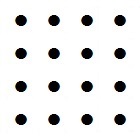
 .
.
Some context for the 4×4 array —
The following definition indicates that the 4×4 array, when
suitably coordinatized, underlies the Kummer lattice .

Further background on the Kummer lattice:
Alice Garbagnati and Alessandra Sarti,
"Kummer Surfaces and K3 surfaces
with $(Z/2Z)^4$ symplectic action."
To appear in Rocky Mountain J. Math. —
The above article is written from the viewpoint of traditional
algebraic geometry. For a less traditional view of the underlying
affine 4-space from finite geometry, see the website
Finite Geometry of the Square and Cube.
Some further context …
"To our knowledge, the relation of the Golay code
to the Kummer lattice … is a new observation."
— Anne Taormina and Katrin Wendland,
"The overarching finite symmetry group of
Kummer surfaces in the Mathieu group M24 "
As noted earlier, Taormina and Wendland seem not to be aware of
R. W. H. T. Hudson's use of the (uncoordinatized*) 4×4 array in his
1905 book Kummer's Quartic Surface. The array was coordinatized,
i.e. given a "vector space structure," by Cullinane eight years prior to
the cited remarks of Curtis.
* Update of Sept. 14: "Uncoordinatized," but parametrized by 0 and
the 15 two-subsets of a six-set. See the post of Sept. 13.
Wednesday, August 24, 2016
Core Statements
"That in which space itself is contained" — Wallace Stevens
An image by Steven H. Cullinane from April 1, 2013:
The large Desargues configuration of Euclidean 3-space can be
mapped canonically to the 4×4 square of Galois geometry —
On an Auckland University of Technology thesis by Kate Cullinane —

The thesis reportedly won an Art Directors Club award on April 5, 2013.
Tuesday, September 9, 2014
Smoke and Mirrors
This post is continued from a March 12, 2013, post titled
"Smoke and Mirrors" on art in Tromsø, Norway, and from
a June 22, 2014, post on the nineteenth-century
mathematicians Rosenhain and Göpel.
The latter day was the day of death for
mathematician Loren D. Olson, Harvard '64.
For some background on that June 22 post, see the tag
Rosenhain and Göpel in this journal.
Some background on Olson, who taught at the
University of Tromsø, from the American Mathematical
Society yesterday:
Olson died not long after attending the 50th reunion of the
Harvard Class of 1964.
For another connection between that class (also my own)
and Tromsø, see posts tagged "Elegantly Packaged."
This phrase was taken from today's (print)
New York Times review of a new play titled "Smoke."
The phrase refers here to the following "package" for
some mathematical objects that were named after
Rosenhain and Göpel — a 4×4 array —
For the way these objects were packaged within the array
in 1905 by British mathematician R. W. H. T. Hudson, see
a page at finitegometry.org/sc. For the connection to the art
in Tromsø mentioned above, see the diamond theorem.
Sunday, August 24, 2014
Symplectic Structure…
In the Miracle Octad Generator (MOG):
The above details from a one-page note of April 26, 1986, refer to the
Miracle Octad Generator of R. T. Curtis, as it was published in 1976:
From R. T. Curtis (1976). A new combinatorial approach to M24,
Mathematical Proceedings of the Cambridge Philosophical Society ,
79, pp 25-42. doi:10.1017/S0305004100052075.
The 1986 note assumed that the reader would be able to supply, from the
MOG itself, the missing top row of each heavy brick.
Note that the interchange of the two squares in the top row of each
heavy brick induces the diamond-theorem correlation.
Note also that the 20 pictured 3-subsets of a 6-set in the 1986 note
occur as paired complements in two pictures, each showing 10 of the
3-subsets.
This pair of pictures corresponds to the 20 Rosenhain tetrads among
the 35 lines of PG(3,2), while the picture showing the 2-subsets
corresponds to the 15 Göpel tetrads among the 35 lines.
See Rosenhain and Göpel tetrads in PG(3,2). Some further background:
Friday, August 15, 2014
The Omega Matrix
The webpage Rosenhain and Göpel Tetrads in PG(3,2)
has been updated to include more material on symplectic structure.
Monday, August 11, 2014
Syntactic/Symplectic
(Continued from August 9, 2014.)
Syntactic:
Symplectic:
"Visual forms— lines, colors, proportions, etc.— are just as capable of
articulation , i.e. of complex combination, as words. But the laws that govern
this sort of articulation are altogether different from the laws of syntax that
govern language. The most radical difference is that visual forms are not
discursive . They do not present their constituents successively, but
simultaneously, so the relations determining a visual structure are grasped
in one act of vision."
– Susanne K. Langer, Philosophy in a New Key
For examples, see The Diamond-Theorem Correlation
in Rosenhain and Göpel Tetrads in PG(3,2).
This is a symplectic correlation,* constructed using the following
visual structure:
 .
.
* Defined in (for instance) Paul B. Yale, Geometry and Symmetry ,
Holden-Day, 1968, sections 6.9 and 6.10.
Wednesday, August 6, 2014
Symplectic Structure*
From Gotay and Isenberg, "The Symplectization of Science,"
Gazette des Mathématiciens 54, 59-79 (1992):
"… what is the origin of the unusual name 'symplectic'? ….
Its mathematical usage is due to Hermann Weyl who,
in an effort to avoid a certain semantic confusion, renamed
the then obscure 'line complex group' the 'symplectic group.'
… the adjective 'symplectic' means 'plaited together' or 'woven.'
This is wonderfully apt…."

The above symplectic structure** now appears in the figure
illustrating the diamond-theorem correlation in the webpage
Rosenhain and Göpel Tetrads in PG(3,2).
Some related passages from the literature:


* The title is a deliberate abuse of language .
For the real definition of "symplectic structure," see (for instance)
"Symplectic Geometry," by Ana Cannas da Silva (article written for
Handbook of Differential Geometry, vol 2.) To establish that the
above figure is indeed symplectic , see the post Zero System of
July 31, 2014.
** See Steven H. Cullinane, Inscapes III, 1986
Monday, August 4, 2014
A Wrinkle in Space
"There is such a thing as a tesseract." — Madeleine L'Engle
An approach via the Omega Matrix:
See, too, Rosenhain and Göpel as The Shadow Guests .
Friday, August 1, 2014
The Diamond-Theorem Correlation
Click image for a larger, clearer version.
Sunday, June 8, 2014
Vide

"The relevance of a geometric theorem is determined by what the theorem
tells us about space, and not by the eventual difficulty of the proof."
— Gian-Carlo Rota discussing the theorem of Desargues
What space tells us about the theorem :
In the simplest case of a projective space (as opposed to a plane ),
there are 15 points and 35 lines: 15 Göpel lines and 20 Rosenhain lines.*
The theorem of Desargues in this simplest case is essentially a symmetry
within the set of 20 Rosenhain lines. The symmetry, a reflection
about the main diagonal in the square model of this space, interchanges
10 horizontally oriented (row-based) lines with 10 corresponding
vertically oriented (column-based) lines.
Vide Classical Geometry in Light of Galois Geometry.
* Update of June 9: For a more traditional nomenclature, see (for instance)
R. Shaw, 1995. The "simplest case" link above was added to point out that
the two types of lines named are derived from a natural symplectic polarity
in the space. The square model of the space, apparently first described in
notes written in October and December, 1978, makes this polarity clearly visible:
Sunday, February 16, 2014
Sermon
ROSENCRANTZ:
… Do you ever think of yourself as
actually dead, lying in a box with a lid on it?
GUILDENSTERN:
No.
ROSENCRANTZ:
Nor do I, really… It's silly to be depressed by it.
I mean one thinks of it like being alive in a box,
one keeps forgetting to take into account the fact
that one is dead… which should make all the
difference… shouldn't it? I mean, you'd never know
you were in a box, would you? It would be just like
being asleep in a box.
— Tom Stoppard
See also last Sunday's sermon (Feb. 9) and
Mystery Box III: Inside, Outside (Feb. 10).
Monday, February 10, 2014
Mystery Box III: Inside, Outside
(Continued from Mystery Box, Feb. 4, and Mystery Box II, Feb. 5.)
The Box

Inside the Box
Outside the Box
For the connection of the inside notation to the outside geometry,
see Desargues via Galois.
(For a related connection to curves and surfaces in the outside
geometry, see Hudson's classic Kummer's Quartic Surface and
Rosenhain and Göpel Tetrads in PG(3,2).)
Saturday, September 21, 2013
Geometric Incarnation
The Kummer 166 configuration is the configuration of sixteen
6-sets within a 4×4 square array of points in which each 6-set
is determined by one of the 16 points of the array and
consists of the 3 other points in that point's row and the
3 other points in that point's column.
See Configurations and Squares.
The Wikipedia article Kummer surface uses a rather poetic
phrase* to describe the relationship of the 166 to a number
of other mathematical concepts — "geometric incarnation."
Related material from finitegeometry.org —
* Apparently from David Lehavi on March 18, 2007, at Citizendium .
Mathematics and Narrative (continued)
Mathematics:
A review of posts from earlier this month —
Wednesday, September 4, 2013
|
Narrative:

Aooo.
Happy birthday to Stephen King.
Thursday, September 5, 2013
Wednesday, September 4, 2013
Saturday, August 17, 2013
Up-to-Date Geometry
The following excerpt from a January 20, 2013, preprint shows that
a Galois-geometry version of the large Desargues 154203 configuration,
although based on the nineteenth-century work of Galois* and of Fano,**
may at times have twenty-first-century applications.

Atkinson's paper does not use the square model of PG(3,2), which later
in 2013 provided a natural view of the large Desargues 154203 configuration.
See my own Classical Geometry in Light of Galois Geometry. Atkinson's
"subset of 20 lines" corresponds to 20 of the 80 Rosenhain tetrads
mentioned in that later article and pictured within 4×4 squares in Hudson's
1905 classic Kummer's Quartic Surface.
* E. Galois, definition of finite fields in "Sur la Théorie des Nombres,"
Bulletin des Sciences Mathématiques de M. Férussac,
Vol. 13, 1830, pp. 428-435.
** G. Fano, definition of PG(3,2) in "Sui Postulati Fondamentali…,"
Giornale di Matematiche, Vol. 30, 1892, pp. 106-132.
Sunday, May 19, 2013
Sermon
Best vs. Bester
The previous post ended with a reference mentioning Rosenhain.
For a recent application of Rosenhain's work, see
Desargues via Rosenhain (April 1, 2013).
From the next day, April 2, 2013:
"The proof of Desargues' theorem of projective geometry
comes as close as a proof can to the Zen ideal.
It can be summarized in two words: 'I see!' "
– Gian-Carlo Rota in Indiscrete Thoughts (1997)
Also in that book, originally from a review in Advances in Mathematics ,
Vol. 84, Number 1, Nov. 1990, p. 136:

See, too, in the Conway-Sloane book, the Galois tesseract …
and, in this journal, Geometry for Jews and The Deceivers , by Bester.
Priority Claim
From an arXiv preprint submitted July 18, 2011,
and last revised on March 11, 2013 (version 4):
"By our construction, this vector space is the dual
of our hypercube F24 built on I \ O9. The vector space
structure of the latter, to our knowledge, is first
mentioned by Curtis in [Cur89]. Hence altogether
our proposition 2.3.4 gives a novel geometric
meaning in terms of Kummer geometry to the known
vector space structure on I \ O9."
[Cur89] reference:
R. T. Curtis, "Further elementary techniques using
the miracle octad generator," Proc. Edinburgh
Math. Soc. 32 (1989), 345-353 (received on
July 20, 1987).
— Anne Taormina and Katrin Wendland,
"The overarching finite symmetry group of Kummer
surfaces in the Mathieu group M 24 ,"
arXiv.org > hep-th > arXiv:1107.3834
"First mentioned by Curtis…."
No. I claim that to the best of my knowledge, the
vector space structure was first mentioned by me,
Steven H. Cullinane, in an AMS abstract submitted
in October 1978, some nine years before the
Curtis article.
|
Update of the above paragraph on July 6, 2013—
No. The vector space structure was described by
The vector space structure as it occurs in a 4×4 array |
See Notes on Finite Geometry for some background.
See in particular The Galois Tesseract.
For the relationship of the 1978 abstract to Kummer
geometry, see Rosenhain and Göpel Tetrads in PG(3,2).
Friday, April 19, 2013
The Large Desargues Configuration
Desargues' theorem according to a standard textbook:
"If two triangles are perspective from a point
they are perspective from a line."
The converse, from the same book:
"If two triangles are perspective from a line
they are perspective from a point."
Desargues' theorem according to Wikipedia
combines the above statements:
"Two triangles are in perspective axially [i.e., from a line]
if and only if they are in perspective centrally [i.e., from a point]."
A figure often used to illustrate the theorem,
the Desargues configuration , has 10 points and 10 lines,
with 3 points on each line and 3 lines on each point.
A discussion of the "if and only if" version of the theorem
in light of Galois geometry requires a larger configuration—
15 points and 20 lines, with 3 points on each line
and 4 lines on each point.
This large Desargues configuration involves a third triangle,
needed for the proof (though not the statement ) of the
"if and only if" version of the theorem. Labeled simply
"Desargues' Theorem," the large configuration is the
frontispiece to Volume I (Foundations) of Baker's 6-volume
Principles of Geometry .
Point-line incidence in this larger configuration is,
as noted in a post of April 1, 2013, described concisely
by 20 Rosenhain tetrads (defined in 1905 by
R. W. H. T. Hudson in Kummer's Quartic Surface ).
The third triangle, within the larger configuration,
is pictured below.
Saturday, April 13, 2013
Princeton’s Christopher Robin
The title is that of a talk (see video) given by
George Dyson at a Princeton land preservation trust,
reportedly on March 21, 2013. The talk's subtitle was
"Oswald Veblen and the Six-hundred-acre Woods."
Meanwhile…
Thursday, March 21, 2013
|
Related material for those who prefer narrative
to mathematics:
|
Log24 on June 6, 2006:
The Omen :
|
Related material for those who prefer mathematics
to narrative:
What the Omen narrative above and the mathematics of Veblen
have in common is the number 6. Veblen, who came to
Princeton in 1905 and later helped establish the Institute,
wrote extensively on projective geometry. As the British
geometer H. F. Baker pointed out, 6 is a rather important number
in that discipline. For the connection of 6 to the Göpel tetrads
figure above from March 21, see a note from May 1986.
See also last night's Veblen and Young in Light of Galois.
"There is such a thing as a tesseract." — Madeleine L'Engle
Wednesday, April 10, 2013
Caution: Slow Art
"Of course, DeLillo being DeLillo,
it’s the deeper implications of the piece —
what it reveals about the nature of
film, perception and time — that detain him."
— Geoff Dyer, review of Point Omega
Related material:
A phrase of critic Robert Hughes,
"slow art," in this journal.
A search for that phrase yields the following
figure from a post on DeLillo of Oct. 12, 2011:

The above 3×3 grid is embedded in a
somewhat more sophisticated example
of conceptual art from April 1, 2013:
Update of April 12, 2013
The above key uses labels from the frontispiece
to Baker's 1922 Principles of Geometry, Vol. I ,
that shows a three-triangle version of Desargues's theorem.
A different figure, from a site at National Tsing Hua University,
shows the three triangles of Baker's figure more clearly:
Wednesday, April 3, 2013
Museum Piece
Roberta Smith in 2011 on the American Folk Art Museum (see previous post):
"It could be argued that we need a museum of folk art
the way we need a museum of modern art,
to shine a very strong, undiluted light on
a very important achievement."
Some other aesthetic remarks:
"We have had a gutful of fast art and fast food.
What we need more of is slow art: art that holds time
as a vase holds water: art that grows out of modes
of perception and whose skill and doggedness
make you think and feel; art that isn't merely sensational,
that doesn't get its message across in 10 seconds,
that isn't falsely iconic, that hooks onto something
deep-running in our natures. In a word, art that is
the very opposite of mass media. For no spiritually
authentic art can beat mass media at their own game."
— Robert Hughes, speech of June 2, 2004,
quoted here June 15, 2007.
Perhaps, as well as museums of modern art and of folk art,
we need a Museum of Slow Art.
One possible exhibit, from this journal Monday:
The diagram on the left is from 1922. The 20 small squares at right
that each have 4 subsquares darkened were discussed, in a different
context, in 1905. They were re-illustrated, in a new context
(Galois geometry), in 1986. The "key" square, and the combined
illustration, is from April 1, 2013. For deeper background, see
Classical Geometry in Light of Galois Geometry.
Those who prefer faster art may consult Ten Years After.
Tuesday, April 2, 2013
Hermite
A sequel to the quotation here March 8 (Pinter Play)
of Joan Aiken's novel The Shadow Guests—

Supposing that one's shadow guests are
Rosenhain and Göpel (see March 18)…
Hans Freudenthal at Encyclopedia.com on Charles Hermite:
"In 1855 Hermite took advantage of Göpel’s and Rosenhain’s work
when he created his transformation theory (see below)."
"One of his invariant theory subjects was the fifth-degree equation,
to which he later applied elliptic functions.
Armed with the theory of invariants, Hermite returned to
Abelian functions. Meanwhile, the badly needed theta functions
of two arguments had been found, and Hermite could apply what
he had learned about quadratic forms to understanding the
transformation of the system of the four periods. Later, Hermite’s
1855 results became basic for the transformation theory of Abelian
functions as well as for Camille Jordan’s theory of 'Abelian' groups.
They also led to Herrnite’s own theory of the fifth-degree equation
and of the modular equations of elliptic functions. It was Hermite’s
merit to use ω rather than Jacobi’s q = eπi ω as an argument and to
prepare the present form of the theory of modular functions.
He again dealt with the number theory applications of his theory,
particularly with class number relations or quadratic forms.
His solution of the fifth-degree equation by elliptic functions
(analogous to that of third-degree equations by trigonometric functions)
was the basic problem of this period."
See also Hermite in The Catholic Encyclopedia.
Thursday, March 21, 2013
Geometry of Göpel Tetrads (continued)
An update to Rosenhain and Göpel Tetrads in PG(3,2)
supplies some background from
Notes on Groups and Geometry, 1978-1986,
and from a 2002 AMS Transactions paper.
Tuesday, March 19, 2013
Mathematics and Narrative (continued)
Angels & Demons meet Hudson Hawk
Dan Brown's four-elements diamond in Angels & Demons :

The Leonardo Crystal from Hudson Hawk :

Mathematics may be used to relate (very loosely)
Dan Brown's fanciful diamond figure to the fanciful
Leonardo Crystal from Hudson Hawk …
-
Compare Brown's fictional Illuminati Diamond to the
nonfictional figures in The Diamond Theorem and
Theme and Variations. -
Compare the fictional Leonardo Crystal to Hudson's
nonfictional desmic system of tetrahedra (above), and
see, in Rosenhain and Göpel Tetrads in PG(3,2), how
the diamond theorem is related to Hudson's work.
For the tetrads ' relationship to tetrahedra , see
Hudson's own book.
"Giving himself a head rub, Hawk bears down on
the three oddly malleable objects. He TANGLES
and BENDS and with a loud SNAP, puts them together,
forming the Crystal from the opening scene."
— A screenplay of Hudson Hawk
Happy birthday to Bruce Willis.
Monday, March 18, 2013
Back to the Present: The Sequel
|
From Tom Stoppard's play "Rosencrantz and Guildenstern Are Dead"
GUIL: Yes, one must think of the future. |
Related material: Quotes from H. F. Baker in posts from March 2011—
Saturday, March 16, 2013
The Crosswicks Curse
From the prologue to the new Joyce Carol Oates
novel Accursed—
"This journey I undertake with such anticipation
is not one of geographical space but one of Time—
for it is the year 1905 that is my destination.
1905!—the very year of the Curse."
Today's previous post supplied a fanciful link
between the Crosswicks Curse of Oates and
the Crosswicks tesseract of Madeleine L'Engle.
The Crosswicks Curse according to L'Engle
in her classic 1962 novel A Wrinkle in Time —
"There is such a thing as a tesseract."
A tesseract is a 4-dimensional hypercube that
(as pointed out by Coxeter in 1950) may also
be viewed as a 4×4 array (with opposite edges
identified).
Meanwhile, back in 1905…
For more details, see how the Rosenhain and Göpel tetrads occur naturally
in the diamond theorem model of the 35 lines of the 15-point projective
Galois space PG(3,2).
See also Conwell in this journal and George Macfeely Conwell in the
honors list of the Princeton Class of 1905.






